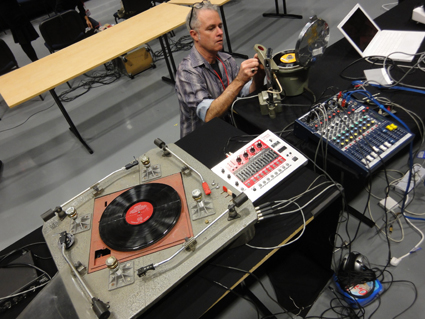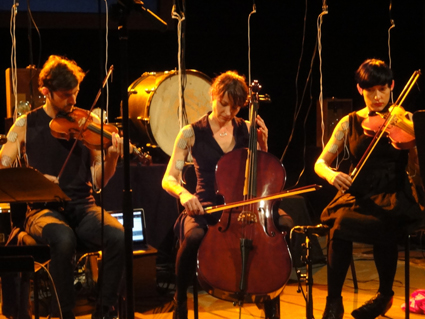 |
Ian Andrews preparing a medical centrifuge modified to play vinyl records at extremely high speeds, with four-arm turntable constructed by John Jacobs photo Alessio Cavallaro |
The first performance by Shane Fahey and collaborators, Time—a token of Consistency, presented a music concrete investigation into the passing of time. A variety of timer devices are set up on drums by “horologist” Evan Carr and amplified. Fahey and David Carr then manipulate these layers of ticks, forming complex rhythmic motifs overlapping and merging in and out of one another. The visual aesthetic is particularly strong, the players positioned around a small installation of wooden boxes housing clocks and light globes accompanied by Honi Ryan’s video projected onto the skin of a bass drum. Here noirish shadows wait and pace, overlaid by images of a swinging pendulum, ticking clocks and the moon, beautifully textured and perfectly fitting on the drum’s surface. When the final timer goes off, the performance is over—neat and nicely done.
Decibel from Perth performed in a cut down configuration featuring Cat Hope on bass flute and Lindsay Vickery on bass clarinet and Sydney-based guests Mark Cauvin on double bass and Jon Watts on laptop. Using their custom designed app, ScorePlayer, the ensemble performed two new graphic scores projected for both players and audience to follow. The first, Silent Revolution by Lindsay Vickery, combines a notation of coloured lines with collaged black and white images of historical revolts that gradually become increasingly abstracted. The players are prompted to make short staccato eruptions developing into longer more intertwined atonal sequences. The rich rabble of sound manipulated by Watts on laptop near the conclusion of the score is particularly interesting as is its visual correlation of dense larva-like texture. The second piece, Lower Drawer by Cat Hope, consists purely of coloured lines dictating sustained tones and small pitch bends and glissandi. It’s a quiet and ambiguous piece—always in the process of becoming and never arriving, an intriguing effect that feels intimately linked to the scrolling mechanism of the score which creates a kind of self-contained chaos.
Nigel Helyer has made known his dissatisfaction with performance laptoppery (see RT70), so it’s no surprise that the majority of the works in Polysonics involve physical, visual or installation components. Garth Paine’s set-up includes five robotic singing bowl contraptions that hang above the audience creating highly spatialised tolling and a series of auto-activated cymbals providing feedback sonorities. The core of the performance is Paine on flute, exploring its high and shrill tonalities (from where I’m placed, occasionally too shrill), which are then processed via laptop and augmented with ambisonic field recordings, predominantly bird sounds. The result is a rich and multifaceted soundscape, reflecting a sense of chatter implied in the title Meditations on Conversation.
 |
Kyle Sanna, Michaela Davies, Lea Simpson, Compositions For Involuntary Strings photo Alessio Cavallaro |
Leah Barclay’s Shifting Nature is purely a laptop performance (Helyer must have overcome his aversion) presenting a radiophonic journey through Australia, India, Korea, China and Brazil. Her recordings are clear and expansive, including insect sounds, voices, instruments ranging from didjeridu to tabla and even, we are told, sounds of the Amazon River Dolphin. Her processing and augmentation of the field recordings is sensitive, drawing out resonances and rhythmic subtleties. Despite the speaker distortion (it seems the audio engineers were unaccustomed to mixing for live performance), it was a rich audio travelogue.
The final performance of the evening is a celebration of old technologies with Ian Andrews and Garry Bradbury (aka Sanity Clause) employing only turntable mechanisms to create their soundscape. However this doesn’t limit the duo to just playing records. On one turntable what appears to be a spring and marbles jostle together to form a rattly texture. They are later replaced by an oscillating plastic bowl. Andrews’ four-arm turntable simultaneously creates its own mash up of sounds while Bradbury drops the needle onto classic vinyl curiosities capturing warm crackly loops. The highlight arrives when Andrews comes to the front of the workstation and switches on an object, later identified as a centrifuge, on which a record spins wildly. The performance ends with the slow slurred tones of the vinyl as it finishes its deceleration. A perfect sonification for the end of ISEA2013.
Polysonics offered a truly eclectic combination of artists. It was a shame the MC-ing by ABC Radio National presenter Tim Ritchie was poorly pitched for the ISEA audience, his cringe-worthy monologues evidencing a distinct lack of engagement with the music. While there was a marked absence of younger sound-makers (many of whom were performing at the First Draft Depot gig unfortunately programmed for the same night), the range of artists offered multiple perspectives on audio production and an impressive breadth of invention.
Polysonics, curators Nigel Helyer, Alessio Cavallaro, presented by ISEA2013 Sydney and ABC Ultimo, ABC TV Studio 22, 15 June; http://www.isea2013.org/
This article first appeared on RT's ISEA2013-in RealTime blog
© Gail Priest; for permission to reproduce apply to [email protected]








 back
back